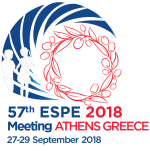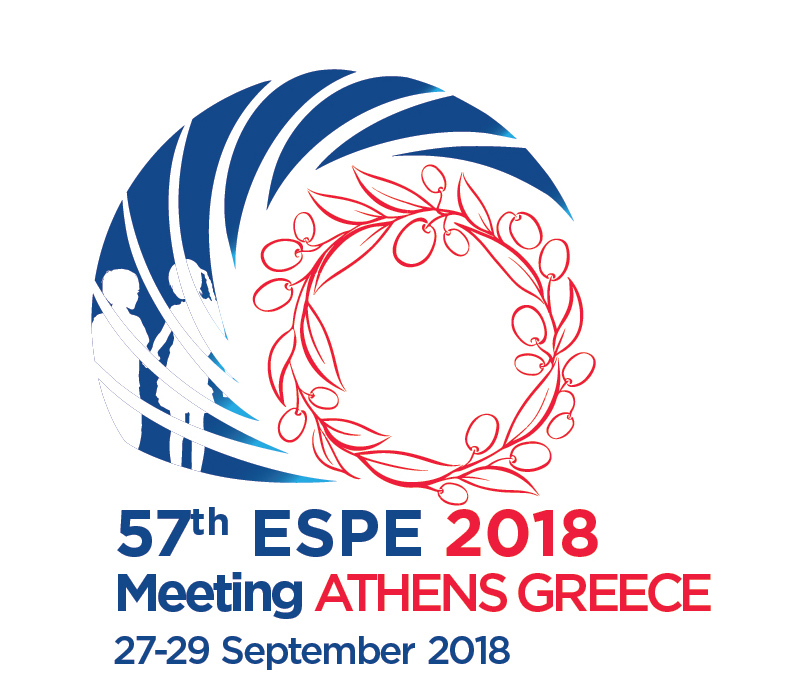
57th Annual ESPE
Athens,
Greece
27 Sep 2018 - 29 Sep 2018

Poster Presentations
Growth & Syndromes P1
hrp0089p1-p159 | Growth & Syndromes P1 | ESPE2018
Does X-Chromosome Gene Dosage Determine Growth and Phenotypic Features in Turner Syndrome with 45,X/46,XX Mosaicism on Standard Karyotyping? A Cross-Sectional Analysis of the French National Rare Disease Network Database
Fiot Elodie , Zenaty Delphine , Pick Paul , Boizeau Patricia , Haignere Jeremy , Dos Santos Sophie , Christin-Maitre Sophie , Carel Jean-Claude , Leger Juliane , Turner Syndrome Study Group French
hrp0089p1-p161 | Growth & Syndromes P1 | ESPE2018
Analysis of Osteoblats Precursors in Girls with Turner Syndrome
Brunetti Giacomina , Chiarito Mariangela , Piacente Laura , Aceto Gabriella , Colucci Silvia , Colaianni Graziana , Grano Maria , D'Amato Gabriele , Felicia Faienza Maria
hrp0089p1-p162 | Growth & Syndromes P1 | ESPE2018
Comparing the Cumulative Dose of Growth Hormone Therapy Using Body Weight-Based Dosing Versus Body Surface Area-Based Dosing in Children with Turner Syndrome – Data from the ANSWER Study
Backeljauw Philippe , Geffner Mitchell , Ross Judith , Holot Natalia , Ostrow Vlady
hrp0089p1-p163 | Growth & Syndromes P1 | ESPE2018
The Association between Growth Hormone Dose and Short-Term Height Outcomes in a Large Cohort of Paediatric Patients with Turner Syndrome: Real-World Data from the NordiNet® International Outcome Study (IOS) and ANSWER Program
Blair Jo , Rohrer Tilman R. , Tonnes Pedersen Birgitte , Roehrich Sebastian , Backeljauw Philippe
hrp0089p1-p164 | Growth & Syndromes P1 | ESPE2018
Changing Patterns of Growth in Prader-Willi Syndrome
Irene Neophytou Georgia , Frixou Mikaela , Guftar Shaikh M. , Kyriakou Andreas
hrp0089p1-p165 | Growth & Syndromes P1 | ESPE2018
Sleep-Disordered Breathing in Children with Prader-Willi Syndrome in relation to Growth Hormone Therapy Onset
Zimmermann Maja , Laemmer Constance , Woelfle Joachim , Goihlke Bettina
hrp0089p1-p166 | Growth & Syndromes P1 | ESPE2018
Safety and Effectiveness of Growth Hormone Treatment in Patients with Prader-Willi Syndrome under 2 Years of Age in a Reference Hospital
Corripio Raquel , Tubau Carla , Cahis Nuria , Perez Jacobo , Rivera Josefa , Gabau Elisabeth
hrp0089p1-p167 | Growth & Syndromes P1 | ESPE2018
Improved Mental and Motor Development During 3 Years of GH Treatment in Very Young Children with Prader-Willi Syndrome
Donze Stephany , Damen Layla , Mahabier Eva , Hokken-Koelega Anita
hrp0089p1-p168 | Growth & Syndromes P1 | ESPE2018
GH Response to GHRH and Arginine in Previously GH-Treated Young Adults with Prader-Willi Syndrome
Donze Stephany , Damen Layla , Hokken-Koelega Anita
hrp0089p1-p169 | Growth & Syndromes P1 | ESPE2018
A Novel Type of Pubertal Height, Weight, and BMI Reference, Aligned for Onset of Puberty
Albertsson-Wikland Kerstin , Niklasson Aimon , Gelander Lars , Holmgren Anton , Aronson Stefan , Sjoberg Agneta , Lissner Lauren
hrp0089p1-p170 | Growth & Syndromes P1 | ESPE2018
Evaluating Cut-offs for Automatic Growth Screening in Swedish Children – Using the Finnish Growth Monitoring Algorithm
Gelander Lars , Niklasson Aimon , Holmgren Anton , Saari Antti , Dunkel Leo , Albertsson-Wikland Kerstin
hrp0089p1-p171 | Growth & Syndromes P1 | ESPE2018
Prospective Study of Growth in Swedish Children Treated with Modified Ketogenic Diet
Svedlund Anna , Hallbook Tove , Magnusson Per , Dahlgren Jovanna , Swolin-Eide Diana
hrp0089p1-p172 | Growth & Syndromes P1 | ESPE2018
Early Gut Microbiota and childhood Growth
Schei Kasper , Salamati Saideh , Juliusson Petur Benedikt , Oien Torbjorn , Rudi Knut , Odegard Ronnaug Astri
hrp0089p1-p173 | Growth & Syndromes P1 | ESPE2018
Clinical and Radiological Manifestations in a Large Swedish Family with a Pathogenic Heterozygous ACAN Variant
Gkourogianni Alexandra , Segerlund Emma , Hallgrimsdottir Sigrun , Nilsson Ola , Stattin Eva-Lena
hrp0089p1-p174 | Growth & Syndromes P1 | ESPE2018
Identification of ADAMTS6 as a Novel Candidate Gene for Idiopathic Short Stature with Advanced Bone Maturation
Warman Diana M , Ramirez Pablo , Marino Roxana , Garrido Natalia Perez , Touzon Maria Sol , Pentreath Matias Pujana , Mattone Maria Celeste , Rivarola Marco , Belgorosky Alicia
hrp0089p1-p175 | Growth & Syndromes P1 | ESPE2018
Dual Function of the Retinoic Acid Catabolizing Enzyme CYP26C1 – Underlying Idiopathic Short Stature and Modifying Disease Severity in SHOX Deficiency
Montalbano Antonino , Juergensen Lonny , Fukami Maki , Thiel Christian T , Hauer Nadine H , Fricke-Otto Susanne , Binder Gerhard , Naiki Y , Ogata Tsutomu , Hassel David , Rappold Gudrun A
hrp0089p1-p176 | Growth & Syndromes P1 | ESPE2018
Growth Plate Disorders are the Main Cause of Severe Familiar Short Stature in Children Classified and Treated with Growth Hormone as SGA or GHD
Plachy Lukaš , Strakova Veronika , Elblova Lenka , Dušatkova Petra , Obermannova Barbora , Šnajderova Marta , Kolouškova Stanislava , Zemkova Dana , Šumnik Zdeněk , Lebl Jan , Průhova Štěpanka
hrp0089p1-p177 | Growth & Syndromes P1 | ESPE2018
Genetic Investigation of Children with Syndromic Prenatal Onset Short Stature
Homma Thais , Freire Bruna , Ronjo Rachel , Dauber Andrew , Funari Mariana , Lerario Antonio , Arnhold Ivo , Canton Ana , Sugayama Sofia , Bertola Debora , Kim Chong , Malaquias Alexsandra , Jorge Alexander
hrp0089p1-p178 | Growth & Syndromes P1 | ESPE2018
Identification of Three Novel Mutations in 10 Pediatric Patients with Unexplained Syndromic Short Stature Identified by Targeted Exome Sequencing in Korea
hrp0089p1-p179 | Growth & Syndromes P1 | ESPE2018
Beckwith Wiedemann Syndrome: First International Consensus Regarding Diagnosis and Clinical Management
Brioude Frederic , Kalish Jennifer M. , Mussa Alessandro , C. Foster Alison , Bliek Jet , Ferrero Giovanni B. , Boonen Susanne E. , Baker Robert , Bertoletti Monica , Cocchi Guido , Coze Carole , Pellegrin Maurizio De , Hussain Khalid , Krajewska-Walasek Malgorzata , Kratz Christian P. , Bouc Yves Le , Maas Saskia M. , Ounap Katrin , Peruzzi Licia , Rossignol Sylvie , Russo Silvia , Shipster Caroleen , Skorka Agata , Tatton-Brown Katrina , Tenorio Jair , Tortora Chiara , Gronskov Karen , Netchine Irene , Hennekam Raoul C. , Prawitt Dirk , Tumer Zeynep , Eggermann Thomas , Mackay Deborah J. G. , Riccio Andrea , Maher Eamonn R.
hrp0089p1-p180 | Growth & Syndromes P1 | ESPE2018
Silver Russell and Beckwith-Wiedemann Syndromes: Mosaic Distribution of Epigenetic Anomalies
Pham Aurelie , Giabicani Eloise , Steunou Virginie , Netchine Irene , Brioude Frederic
hrp0089p1-p181 | Growth & Syndromes P1 | ESPE2018
Long Term Effects of Childhood Growth Hormone Treatment on Height and Body Mass Index in Adolescents and Adults with Silver-Russell Syndrome
Lokulo-Sodipe Oluwakemi , Canton Ana P. M. , Giabicani Eloise , Ferrand Nawfel , Child Jenny , Wakeling Emma L. , Binder Gerhard , Netchine Irene , Mackay Deborah J.G. , Inskip Hazel M. , Byrne Christopher D. , Davies Justin H. , Temple I. Karen
hrp0089p1-p182 | Growth & Syndromes P1 | ESPE2018
Year-one Effectiveness and Overall Safety of NutropinAq® for Growth Hormone Deficiency (GHD) and Other Paediatric Growth Disorders: Completion of the International Cooperative Growth Study (iNCGS) European Registry
Coutant Regis , Munoz Jordi Bosch , Dumitrescu Cristina , Schnabel Dirk , Sert Caroline , Perrot Valerie , Dattani Mehul
hrp0089p1-p183 | Growth & Syndromes P1 | ESPE2018
Carriers of IGF1-receptor Mutations As A Subgroup of SGA Patients: A Comprehensive Retrospective Comparison of Response to rhGH Treatment and Health Profile
Gopel Eric , Klammt Jurgen , Rockstroh Denise , Pfaffle Heike , Schlicke Marina , Bechtold-Dalla Pozza Susanne , Gannage-Yared Marie-Helene , Gucev Zoran , Mohn Angelika , Harmel Eva-Maria , Volkmann Julia , Bogatsch Holger , Beger Christoph , Gausche Ruth , Weihrauch-Bluher Susann , Pfaffle Roland
hrp0089p1-p184 | Growth & Syndromes P1 | ESPE2018
Characteristics, Effectiveness and Safety Data for Patients with Growth Failure Treated with Recombinant IGF-I (rhIGF-I) and Achieving Adult or Near-adult Height (AH): Results from the European Increlex® Growth Forum Database (EU-IGFD) Registry
Polak Michel , Woelfle Joachim , Perrot Valerie , Sert Caroline , Bang Peter
hrp0089p1-p185 | Growth & Syndromes P1 | ESPE2018
Growth Outcome in Girls with Idiopathic Central Precocious Puberty Treated with Gonadotropin-releasing Hormone Agonist
hrp0089p1-p186 | Growth & Syndromes P1 | ESPE2018
Maternal Uniparental Disomy for Chromosome 20: Physical and Endocrinological Characteristics of Six Patients
Kawashima Sayaka , Nakamura Akie , Inoue Takanobu , Matsubara Keiko , Horikawa Reiko , Wakui Keiko , Takano Kyoko , Fukushima Yoshimitsu , Tatematsu Toshi , Mizuno Seiji , Tsubaki Junko , Kure Shigeo , Matsubara Yoichi , Ogata Tsutomu , Nagasaki Keisuke , Fukami Maki , Kagami Masayo
hrp0089p1-p187 | Growth & Syndromes P1 | ESPE2018
A Novel Deadly Variant in the TP53 Gene Causing Li-Fraumeni Syndrome. The Importance of Clinical Awareness and the Contribution of Molecular Diagnosis in Active Prevention Within Families with Multiple Tumor Incidents at a Young Age
Bothou Christina , Spyridis Georgios P , Papantonatos Dionysios A , Stratakis Constantine A , Papadimitriou Dimitrios T
hrp0089p1-p188 | Growth & Syndromes P1 | ESPE2018



